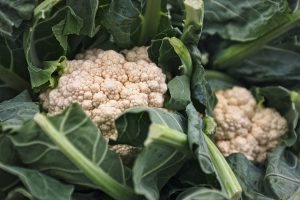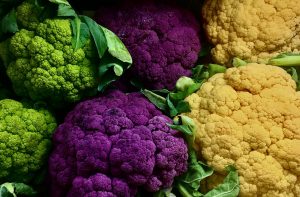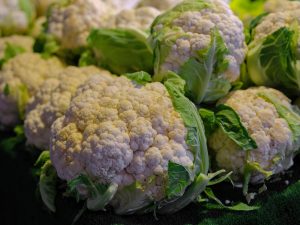Looks like a flower, is a vegetable; cauliflower is making a huge comeback in the modern culinary scene, with influencers on social media creating innovative recipes like cauliflower steak with this wonderful flower-vegetable.
With recent developments in food technology, have you ever wondered whether cauliflower is a naturally occurring vegetable or a selectively bred one? In this article, we answer the question: Is cauliflower a natural vegetable or a man-made creation? Read on to find out.

Is Cauliflower Man-Made?
Yes, cauliflower is a man-made plant, but not in the way you think. The cauliflower plant was created by human influence (cross-breeding), meaning that it has been selectively bred and genetically modified by farmers over millennia. It is a cultivar of the same wild cabbage species which is the parent of many other vegetables in the Brassica oleracea family.
History of Cauliflower
Ancient Cultivation and Early Records
The earliest known records of cauliflower dates back to the Middle Ages wherein the 12th- and 13th-century Arab botanists Ibn al-‘Awwam and Ibn al-Baitar trace its origins to Cyprus. For this reason, they were known as Cyprus colewort in Western Europe where they were exported through trade well into the 16th century.
According to Flower Development: Origin of the cauliflower by David R. Smyth, cauliflower gained popularity in various parts of Europe in the late 15th-century. Although, this early form of the vegetable was quite different from the present day cauliflower.
Wild Ancestor, Brassica Oleracea
As mentioned earlier, cauliflower is a cultivar of wild cabbage (Brassica oleracea). Cultivar indicates any plant variety which has been cultivated through selective breeding. In its original, uncultivated form, wild cabbage is native to coastal southern and western Europe. Its leaves are fleshier than other Brassica species and it also produces a flower spike with numerous yellow flowers.
A recent 2021 study showed that the Brassica cretica, native to the Eastern Mediterranian was the origin of domesticated Brassica oleracea.
Evolution Through Selective Breeding
The taste, texture, size of present day cauliflower is the result of selective breeding spanning over thousands of years. Selective breeding does not happen overnight; it can take anywhere from 5 years to several generations before a species could start producing all the desirable traits.
Also Read: Is Vertical Farming Cost Effective?.
The Role of Human Intervention
1. Introduction to Selective Breeding
Genetic modification through selective breeding is not a recent development in farming practices. Humans have used selective breeding to cultivate and domesticate plants and animals since time immemorial. Unlike GMOs, selective breeding occurs naturally with some human intervention (and in some cases, without).
Selective breeding is a process by which only desired traits are replanted. In other words, man-made vegetables are created with desirable characteristics to produce a certain type of fruit or vegetable.
Desirable traits include factors relating to better flavor, texture, size, increased yield, and resilience to pests, disease, or unfavorable weather. In some cases, hybrid plants occur naturally through cross pollination, thanks to natural pollinators like insects.
To understand the human influence in creating new cultivars, let’s discuss the all-natural method first.
A plant’s reproductive system contains a male part (the stamen) and a female part (pistil), respectively. Pollination is the process where the pollen travels from the stamen to a pistil. Without human intervention, pollen travels from stamen to pistil via natural pollinators (wind, animals, birds or insects).
In a nutshell, selective breeding includes controlled pollination. Humans manually transfer pollen from the stamen of a plant with desirable characteristics to the pistil of another plant also with desirable traits. This involves cross pollination, the phenomenon where the stamen and the pistil come from two genetically different species.
Other methods of selective breeding include grafting, cutting, and layering.
Also Read: Cyborg Insects.
2. Varieties of Cauliflower and Their Characteristics
Today, after several decades of research and development, there exist hundreds of varieties of cauliflower. They come in a range of colors like green, purple, yellow, brown, and even orange! Cauliflower varieties can be categorized into four main categories: Italian cauliflower, Northern European annuals, Northwest European biennial, and Asian cauliflower.

-
Italian Cauliflower
Italian Cauliflower includes various Romanesco, white, yellow, green, purple and brown cultivars. These biennial and annual types are the ancestral form from which other types are derived.
-
Northern European annuals
Developed in Germany in the 18th-century, this type is typically harvested during summer or fall, and includes the cultivars Erfurt and Snowball.
-
Northwest European biennial
Developed in France during the 19th-century, this type is harvested in winter and early spring, and includes the cultivars Angers and Roscoff.
-
Asian cauliflower
Developed in India during the 19th-century, this type has some of the most flavourful cultivars including Early Benaras, Early Patna and Taishan cauliflower.
3. Influence of Human Intervention on Present Day Cauliflower
Now that we have discussed selective breeding, you know the importance of human influence in creating new cultivars. The creation or development of modern day cauliflower was a long process of cross-breeding wherein farmers used the flowers clusters of Brassica oleracea to make cauliflower.
In fact, many other vegetables we have today are domesticated varieties made from different parts of the Brassica oleracea plant.
Brassica Oleracea and its Varieties
Here’s a riddle for you: What’s the difference between broccoli and cauliflower? Cauliflower is just broccoli that’s seen a ghost. Jokes aside, have you ever wondered why broccoli and cauliflower look similar? Well, that’s because they have the same parent plant. That’s right, several plants including kohlrabi, kale, Brussels sprouts, and cabbage are made with different parts of the Brassica oleracea plant.
Brassica oleracea var. Botrytis (cauliflower) belongs to the Brassicaceae family, commonly known as the mustards, crucifers, or the cabbage family. In fact, Brassica is Latin for cabbage, and olercea means vegetable/herb.
The Brassica oleracea genus includes many common cultivars (cultivated plants) including kale, cabbage, brussels sprouts, cauliflower and broccoli. These crop plants are known for their edible leaves and florets, and are characterized by their stout rosettes and four petaled flowers.
Here is a list of some of the cultivars and which part of Brassica oleracea they are made from:
- Kohlrabi – made out of the stem.
- Kale – derived from the leaves.
- Brussels sprouts – made out of the lateral buds.
- Broccoli – developed from portions of the stem and flowers.
- Cabbage – created from the terminal buds.
- Cauliflower – made out of the flower clusters.
Check out our article on ‘Bees Will Help Scientists Research Biodiversity‘.
Is Cauliflower a Carbohydrate?
Yes, cauliflower contains carbohydrates, but in extremely low amounts. In fact, there are only 5 grams of carbs in a cup of cauliflower, which is much lower than that in a cup of rice (45 grams). This makes cauliflower an amazing choice if you’re on a low-carb diet. You can swapping regular rice for healthier and tastier cauliflower rice in your daily diet.
Apart from being low in carbs, cauliflower is also a non-starchy vegetable encouraged in diabetic diets. If cooked properly, cauliflower could be just as delicious (if not more) as starchy vegetables like corn and potatoes.
Nutrition of Cauliflower

Here is the nutritional value of just one cup or 107 grams of cauliflower:
- Calories: 27
- Fiber: 2 g
- Vitamin C: 58% of the Daily Value (DV)
- Vitamin K: 14% of the DV
- Vitamin B6: 12% of the DV
- Folate: 15% of the DV
- Pantothenic acid: 14% of the DV
- Potassium: 7% of the DV
- Manganese: 9% of the DV
- Choline: 8% of the DV
- Magnesium: 4% of the DV
- Phosphorus: 4% of the DV
Also Read: 3 Incredible Things Scientists Can Grow In Labs.
Final Thoughts
To wrap things up, cauliflower is a wonderfully delicious and nutritious vegetable which is the product of selective breeding using the flower clusters of Brassica oleracea (wild cabbage). The next time you take a bite of cauliflower, think about the science behind its long developmental process which was made successful by generations of farmers.
























